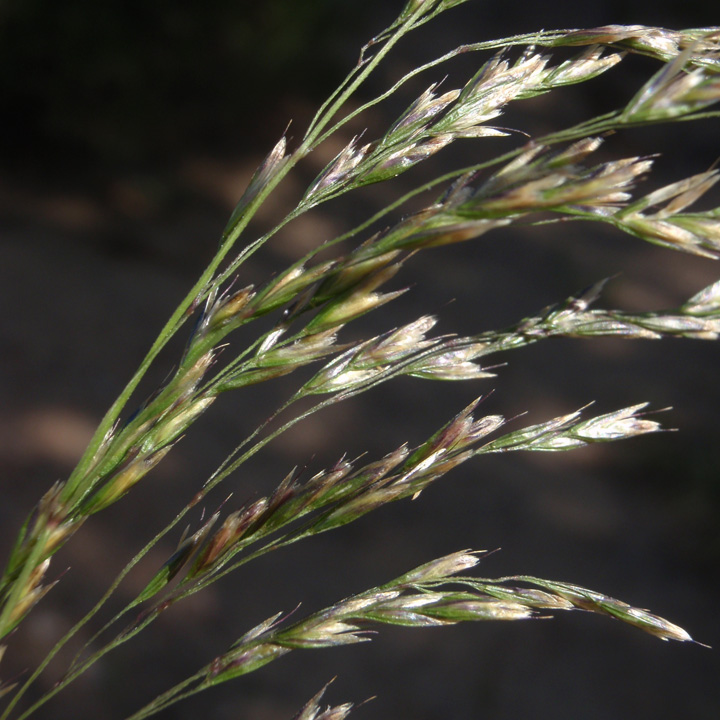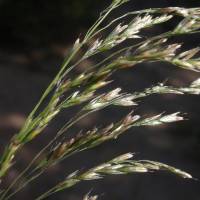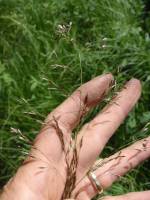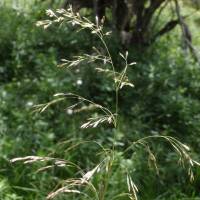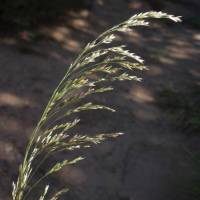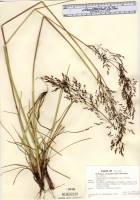I found this species to be a frequent grass in very marly soil in the outlet of a marly, springy place about 6 miles southwest of South Bend, St. Joseph County, and in a cold, marly, springy place on the border of Mill Creek about a mile north of Mill Creek, La Porte County. Only a few plants were seen at the latter station. Bradner reported this species from Steuben County and his determination was, no doubt, correct, but no specimen has been seen.
Densely tufted perennial 3-12 dm; lvs mostly below the middle of the stem, the blades flat or folded, 1-5 mm wide, ligules often elongate to 3-12 mm; infl loose and open to narrow and contracted, the lower branches in fascicles of 2-5; spikelets purplish or silvery, 2.3-5.7 mm, the first glume 2-5.1 mm, the second 2.7-5.3 mm, acute or obtuse and often erose-tipped; rachilla prolonged one-fourth to one-half the length of the upper floret; lemmas glabrous, usually truncate and 4- toothed, the awn attached below the middle, straight or nearly so, from shorter than to barely exceeding the lemma; palea bifid, anthers 1.3-2.3 mm; 2n=24-28, 52, 56. Wet or boggy ground; circumboreal, s. to N.J., W.Va., N.C., Ill., Minn., and Ariz. A complex sp., the vars. not yet well understood.
Gleason, Henry A. & Cronquist, Arthur J. 1991. Manual of vascular plants of northeastern United States and adjacent Canada. lxxv + 910 pp.
©The New York Botanical Garden. All rights reserved. Used by permission.
Common Name: tufted hairgrass
Duration: Perennial
Nativity: Native
Lifeform: Graminoid
General: Widespread densely to loosely clumped slender cool season bunchgrass with stems to 150 cm tall and a loosely branched, open panicle with 2 florets per spikelet.
Vegetative: Blades mostly basal, 5-30 cm long, 1-4 mm wide, some flat but most rolled with a 1 mm diameter; adaxial surfaces with 5-11 ribs; stems erect, 35-150 cm tall; mostly scabrous; ligules 3-8 mm long,narrow, often with an irregularly toothed margin.
Inflorescence: Panicles 8-30 cm long, usually open and pyramid-shaped, sometimes narrowly elongate, often nodding; branches straight and hair-like; spikelets 2-7 mm long, narrowly oblong, laterally compressed, usually bisexual with 2 florets, silver colored with a purple tinge; glumes 3-7 mm long, 1-3 veined, lanceolate; lemmas 2-5 mm, thin,smooth, and shiny, usually with awns 1-8 mm long arising at the middle or lower end of the glume; awns either straight or bent and sometimes longer than glumes; anthers 1-3 mm long.
Ecology: Found in wet meadows and in sand and gravel along rivers, streams and lakes at at 5000-13,000 ft. (1500-4000 m); flowers June-September.
Distribution: Found in the western, northern, and northeastern United States.
Notes: Is strongly polymorphic, with the overlapping diagnostic features within different subspecies in the United States. Differentiated from D. sukatschewii by having basal blades with 5-11 ribs, vs 3-5 ribs. Differentiated from D. brevifolia by having spikelets that do not overlap and that are not in dense clusters. Prefers poorly drained soils. Provides forage for elk.
Ethnobotany: Seeds used for food. Helpful in stabilizing disturbed sites. Good forage for sheep and cattle.
Etymology: Deschampsia is named after the French botanist Louis Auguste Deschamps, who lived from 1766-1842, while caespitosa means having densely clumped or tufted growth.
Editor: LKearsley, 2012


